English | Tiếng Việt |
O precious Sangha, from today onwards, I shall pass into Nirvana and become invisible. Do not ever think or say, “Alas, now that our perfect teacher is no more, we have no teacher.” For the teachings and the disciplinary code that I have taught you throughout my life shall be your teacher.
I wish to thank you all for all the kind support and help you have given me through the years, and I would also like to tell you a little about the monastery.
Tibet is called the roof of the world. It is a beautiful vast land with high mountains, pure water, clean air, blue skies, and white clouds. It is a country where Buddhism prospers, with Buddhists everywhere, and where monasteries are as numerous as flowers in summer. On the other hand it is a country that is undeveloped and poor, where travel is difficult, the wind is freezing, and the weather unpredictable.

The Golog region is an awesome land that is one of the six districts of Qinghai and is south of Qinghai's vast, bright Lake Kokonor. Golog is 77,000 square kilometers in area with a population of about 160,000, over 150,000 of whom are Tibetans. Golog is comprised of six counties and its political economic and cultural center is the town of Dawu.
The beautiful Amnye Machen Mountain reaches a height of 6,282 meters (20,605 feet). Golog has many mountains: snow mountains, rocky mountains, forest, and pasture covered mountains, and grassy plains. It is the source of the famous Yellow River that first winds through Golog. There are numerous rivers and great and small lakes. In this natural environment roam high altitude animals: snow lions, snow leopards, wild yaks, kiang, the Tibetan antelope, and graceful herds of deer. The principal livelihood of the nomadic population depends on their herds of yak and sheep.

My monastery was founded in the 1820s by Do Khyentse Yeshe Dorje (1800-1866), a great master of the nineteenth century who was a rebirth of Rigdzin Jigme Lingpa (1729-1798). At first the monastery consisted of a nomadic yak hair tent of no fixed location moving from one area to another. It barely survived through the invasions by Muslim armies and the Chinese cultural revolution. A succession of lamas with great courage and hard work ensured that the monastery and its traditions continued to exist. In particular the ninth abbot of the monastery, Pema Tumdrak Dorje (1934-2009), or Lama Sang as he was generally known, preserved and protected its Dharma lineage. In 1980 he built the present monastery, which is an officially registered monastery recognized by the Chinese government.

Photo credit: Khandro Pema Lhamo
In order to fulfill the wishes and needs of many people, Lama Sang faced many difficulties to build this monastery. The monastic community began with about thirty monks and eventually expanded to five hundred monks with about a hundred yogis. He built the Bodhanath stupa of the Land of Snows, replicas of the Samye Temple, the Mahabodhi temple of Bodhgaya, and others. However, as impermanence is the nature of things, eventually Lama Sang departed this life for another realm.
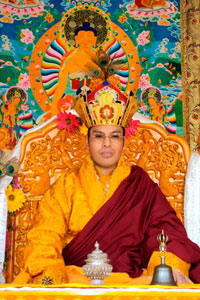
Beginning in 2000 in accordance with Lama Sang's wishes I began to take care of the various activities of the monastery. After Lama Sang's passing, the people living in this region looked to me to fulfill their wishes, their eyes filled with hope and their hands placed together in supplication. I have had no choice but to take this responsibility on my shoulders.
Becoming the abbot of a monastery is the ambition of many people who will struggle and fight for such a position, but this is something that just came to me, that I have been entrusted with. There are many who study Buddhist texts with the secret motive of wishing to become a great master, travel to cities and other countries, build temples and monasteries, and have many pupils. However, during the time I was studying, my sole intention was to progress in my studies and I had no other goal in mind. Therefore, I didn't feel it was a cause for celebration when I suddenly found myself charged with the responsibility of a large monastery.
If one is going to be the abbot of a monastery, one should have studied deeply. There are many abbots who are high lamas with qualities of scholarship, discipline and possessed of a good nature. There are also many abbots who haven't studied, have little knowledge, but gained their position through persistent effort and the power of their wealth. As for me, I was born in this world in difficult times. I was nine years old before I began to learn to read and write. It was a time when everyone lived in great fear, so that they didn't dare study Buddhism or perform Buddhist rituals. The only time we could study was secretly in the middle of the night. At that time, there were no schools in Golog, let alone monasteries. A monk wearing Dharma robes was never to be seen.
When eventually the practice of Buddhism was allowed many of the people I knew were able to wear their monastic robes again and reveal that they were monks. Monastic communities suddenly appeared like a carpet of flowers on the green pastures. Till then they had, by necessity, worn ordinary clothes. It was even rare to see someone with a mala in their hands. Apart from a shaved head there was no indication that the person was a monk. However, those lamas and sanghas kept their Buddhist training pure on the inside and through their kindness we were able to receive from them the nectar of the Buddha's teachings.
As for me I didn't have the best circumstances for studying the Dharma and the various branches of knowledge. However I still think myself fortunate that I have had some education and a propensity for the Dharma compared to the lamas and monks who either because of the difficulties of the times or lacking propensity for the Dharma were not able to study the Dharma at all.
My Dharma lineage is that of the Nyingma's tradition of madhyamaka, the perfection of wisdom, preliminaries, tsalung practice, dzogchen and so on, and I received teachings on all its generation and completion stages. In addition I have studied the view and practice of other traditions such as the Gelugpa. It felt like I was a person with good eyesight being given a telescope to look through.
In addition I have been able to become acquainted with the languages and culture of other countries, which has given me the experience of seeing how other people view the world. I have come to know many people throughout the world and have formed many close friendships with people who remain friends through good and bad times.
It seems to me that in my last life I must have prayed, "May I travel the world, regarding everyone repeatedly with love and kindness, wishing to benefit them with gentle, pleasant words that bring them peace". The friends I have are always kind and gentle to me, while I have nothing to give them but the message of the methods for increasing peace and kindness.
I was born into an ordinary nomadic family following the herds through the four seasons, taking their meat and skins, drinking their milk and eating yoghurt. At that time and in that environment even the word "education" was unknown. The work of herding was passed on through the generations with no tradition of studying or using one\'s brain.
In our area my family was large with much property compared to others. The upheaval of the Cultural Revolution swallowed them whole leaving only a few people and a trace of the wealth. In that difficult time, my mother was under great pressure because she lost almost everything, she had never been to school, had no interest in seeking wealth, and now had to rear five children on her own. When I was a child, all we had to eat were yoghurt in the summer and tsampa in the winter. We never saw any other kind of food as it had become so scarce. Our stomachs were always longing for the taste of bread and rice, but we were very fortunate just to have the yoghurt or tsampa.
I was about eleven or twelve before I first saw cabbage and bokchoy and my tongue was able to touch and taste them. When I think of the conditions that I and my childhood friends lived through, it seems incredible that we are still alive and able to accomplish our goals in life.
As a child I was never able to go to school. My parents and relatives were not able to care for me with love and kindness, as they would have wished to. I grew up in the midst of a storm of fear and danger. I feel very proud that I did not lose the peace and stability of my mind and am now able to travel the world as a messenger of peace of mind.
It is through the kindness of my father that, not only do I have this life, but also this responsibility, which is a great opportunity for benefitting others. When I was a child I was very moved when I listened to stories of the lives of bodhisattvas. They were like the most delicious, nutritious food for my mind. If my mind were a bee, it would always be buzzing around in the flower garden of bodhisattva conduct and would never leave. Even as a child I was determined to follow the conduct of a bodhisattva in this life. Bodhicitta: love and compassion became both my goal in life and my true companions on my journey.
I always want to engage in any activity that will help me to increase my bodhisattva conduct, and I want to avoid any activity that would be harmful to it. I am one of seven billion people that are alive in the world at this time. I'm not a powerful ruler, nor a businessman. I don't have strong desire or malice. I just want to follow the conduct of a bodhisattva. This interest in bodhisattva conduct is not something that was given to me by a deity; I didn't buy it, or get it by force. It came from single-minded good motivation; it is a result of my merit and prayers. Therefore it seems to me I must have been a person with good motivation in many previous lifetimes.
This good motivation during many lifetimes is an act of kindness that has protected me, so that I recognize that I must have achieved something remarkable in those lifetimes. This is not just something that benefits myself alone; it is an instruction that benefits others and myself equally and so I still continue to bring this message of the power of good motivation to everyone.
Good motivation means love, compassion, bodhicitta, and so on. These can only be developed through effort and hard work; they are not going to be accomplished just by spending one\'s time enjoying oneself. Therefore, as good motivation is essential for developing bodhisattva conduct, I see any hardship required for progressing in the conduct of good motivation as worthwhile and necessary. However our greatest problem, the mistake that we regularly make, is that we engage in the eight worldly concerns along with our practice of the Dharma. This is not just an error made by ordinary Dharma practitioners involved in worldly activities; there are many abbots with many pupils, and famous high ranking masters who do this mistake. They say, "This is my tradition, this is my monastery, this is my pupil," clinging to solidity in the depths of their minds. In particular they will say, "These are my pupils", and hold onto them by any means, such as scolding and intimidation. In order to be honored by others they praise themselves, criticize others, and so on. Who are free from the eight worldly concerns and where are they? I take great care because I am very afraid of becoming like that myself.

After Lama Sang passed away I held many meetings with his principal pupils and discussed with them what benefit there would be from continuing to maintain the monastery, and what harm would there be in not doing so. We agreed that we should continue to maintain the monastery because that would keep alive the kindness of Lama Sang. This large sangha will be able to continue hearing, contemplating, and meditating; it will spread the Buddha's teachings; those connected through faith with the monastery will be able to receive Dharma teachings; and there will be unending benefit for practitioners, and so on.
During the three years after Lama Sangs passing, the monastic community continued to grow. However, the existing monk's quarters were falling into disrepair and, at this high altitude, there are cruel winds that can destroy the ground and rocks, let alone human bodies. Therefore, because the monastic saá¹…gha elevates Dharma practice, there was no choice but to build new housing for the monks.
The cost of building materials kept increasing, in particular in China, so that more funds were needed; this is what the nature of the times required. Buddhist monasteries should definitely have a tradition of scripture and realization, which means study and practice, for they are the heart of a monastery. Without study and practice, even if the monastery builds a golden stupa six hundred feet high it would be just an empty facade.
The pupils in Chöig Lobling, which is this monastery's college, are all monks as pure as gold; scholars with pure diligence in hearing and contemplating the teachings; and lifelong monks, who practice contentment and freedom from desires. The education provided in the college is of the highest quality and each year more and more students come from Amdo, Central Tibet, and Kham. However the college building is rudimentary and so are the facilities for the students.
The monastery has a retreat center dedicated to the practice of Vajrakila, where every year each person in the retreat recites a million Vajrasattva and a million Vajrakila mantras. We are important holders of the Dzogchen teaching lineage, and therefore in the future I hope to establish a high quality retreat center for the stages of Dzogchen practice. In the old times there were no nunneries in Golog, and people looked down on women that had taken monastic vows. From my point of view I don't understand why women in general and nuns in particular are not respected. Therefore I founded a nunnery that was the first in Golog. It has a high standard of discipline; the nuns are very humble; and they keep their vows as if they were their eyes. Upon this foundation they have an ever increasing opportunity for studying Dharma and the various branches of knowledge.
We have excellent plans for preserving Lama Sang's own original section of the monastery which is dedicated to the tantra practices of his termas, practicing pujas and annual drupchen according to his teachings. We also found teachers for the yogins and created the facilities for them to study the Dharma and the branches of knowledge.
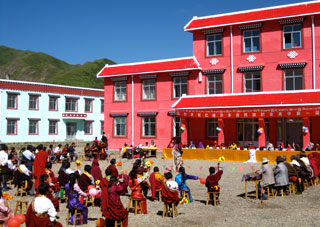
Because I was not able to go to school when I was a child, I still felt there was something missing; I would feel fulfilled only if I could provide young people with the opportunity to study. With the goal of giving young people a brighter future, I spent a number of years working to establish a school where pupils learn languages, writing, and vocational skills. The teachers at the school nurture the pupils with pure motivation and hard work, giving them a high quality education with excellent results and the school has gradually become seen throughout Tibet as a praiseworthy example of a new school.
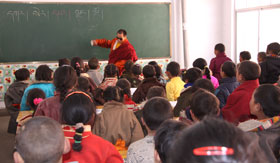
It is not easy to build in my high-altitude homeland with its cold winds and snow. It is also especially difficult to maintain what has been built. In the depth of the winter, the sharpness of the cold weather at that high altitude is like a sharp sword; one can actually see the cold crack the ground open and split rocks. However, in this place there are amazing sights, such as of one of Asia's greatest stupas —the Kangjong Charung Khashor (the Bodhnath Stupa of the Land of Snows). There are many factors required to be able to continually maintain these buildings so that they last a long time.
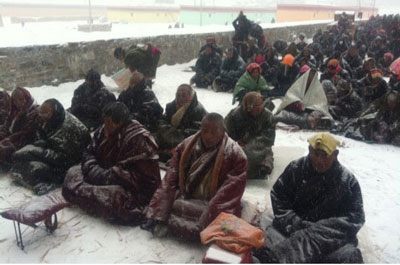
The cold, snow, and winds threaten and weaken everything. However, with great strength of mind and a faith in the Dharma that is as unchanging as a vajra, the people are not intimidated by the cold. It is difficult to comprehend the extent of their dedication to the Dharma. The ground becomes a blend of ice and snow, and fierce, cold winds blow blizzards of snow. Yet the people sit peacefully in the open air to listen to the Dharma. The piercing cold enters their bodies so that they become stiff with cold. Eventually the joints of their body become afflicted by illness, their bodies become bent and their hands and feet become crooked. In the end they are unable to walk properly. Nevertheless they are never dismayed by such hardships and they still come and listen in the open air to the teachings. This seems to be characteristic of Tibetans in general and the Golog people in particular.
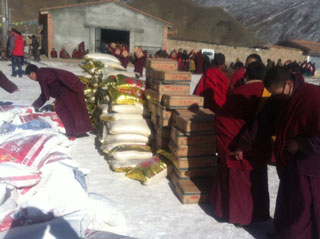
It is traditional for the teacher be seated on a throne, an in the shelter of a beautiful building decorated with impressive colors and flower arrangements. While I have all these necessary facilities and comforts, the huge crowds that come to receive my teachings have to suffer the cold and fall ill. How is it possible to ignore that? I have tried in numerous ways to find a solution to this problem and now I am building a teaching hall, which is large enough to accommodate the thousands that come for the winter Dharma teachings.
The whole world knows that Tibet lags far behind in prosperity. Similarly in Golog there is barely a rudimentary standard of living. In particular, there are elderly people with faith in the Dharma who have settled around the monastery for the purpose of receiving Dharma teachings, circumambulating, without much thought about how they can provide for themselves. There are hundreds of elderly people living beside the monastery entirely dedicated to Dharma practice, with little food or clothing.
Students and practitioners come to the monastery, not just from the surrounding region, but also from all over Tibet. It\'s a center for the Dharma that attracts monks, nuns, the elderly, and lay people who are unable to support themselves. When one sees them suffering from hunger and cold, how can one ignore them? How can one not look at them with kindness? Therefore each year I distribute food and clothing to them.
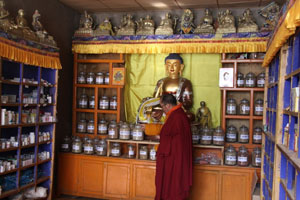
When Lama Sang was young there were many difficulties in this region. When his mother fell ill they didn't have sufficient means to provide her with medicine and so she died. Because of that Lama Sang helped people by providing them with medicine. He made the commitment to distribute medicine whenever he could and each year distributed various kinds of Tibetan medicine to thousands of people in need. Following his example of motivation and activity, I continue every year this wonderful and meritorious activity of distributing medicine to many people.

This monastery had the unique tradition of giving various Dharma teachings to the general lay population. Each winter for many years, Lama Sang also gave many kinds of Dharma teachings to the general population who had faith in the Dharma. He also commanded me that I should give teachings to the lay people as well as the monks. For the past three years since Lama Sang's passing I have in the same way always stayed in Tibet to face the severe cold of the winter for between three months and a hundred days to give detailed teachings on such texts as The Words of My Perfect Teacher, The Instructions on the Six Bardos, Entering the Conduct of the Bodhisattva. This fulfills the deep wishes in the heart of many thousands of people and is a pure conduct to benefit others. Similarly, it is with that good motivation that I visit many places to teach the Dharma.
Tibet has a rich history and culture that could benefit the entire world. It is the responsibility of each successive generation to preserve this ancient tradition of knowledge. We are united in motivation and action in enthusiastically preserving and spreading our culture. I have therefore founded the Gesar Shenpen Foundation, the Mayul Center of Studies, and the Tibetan School For Traditional and Modern Education.
Talk can be impressive, but to actually accomplish something it all comes down to having enough notes and coins, which is the foundation upon which all projects rest. I am not someone who has inherited wealth passed down through the generations. I'm not a businessman that can multiply an investment ten or a hundred times. I am not a politician who cheats people by mixing Dharma and worldly activities. I'm also not someone who uses his high position and power to gain wealth. I'm just someone the raging sea of change has thrown naked out onto the shore. I'm like a beggar who has no interest in business. It is my karma that I'm an alms seeker from a downtrodden family.
The funds I have are not from my parents. I didn't get them by deceiving anyone; what I have is only what friends with good intentions have given me. I know that their income has been earned through the sweat of hard work in a fog of worry, each step hard to take and each load heavy to lift. Who would not be attached to what they've earned that way? I am deeply moved when I think of the hard physical and mental work that earned them that income. I'm not someone who is free of desire, indifferent to possessions and wealth. I'm like a beggar for alms who is happy to receive anything he's given. I'm not an avaricious person who can't bear to use anything he's accumulated. I'm not a selfish person who uses everything he gets for himself. It's my responsibility to use whatever I receive for offerings and charity. I'm not saying this to impress people or praise myself; I'm just being honest and telling the truth about myself.
There are now over seven hundred monks, nuns, and yogins at the monastery; three hundred pupils in the school; and over three hundred elderly people who need to be cared for. I have to take care of them all materially as well as spiritually. With each year the number of monks and nuns that come to study at the monastery increases; in particular, the number of pupils in the school is increasing. Also there are many lay people who are connected by their faith to the monastery. I have to personally take care of the organization, education, and welfare of the monastery and those connected with it.
If the offerings given by those with faith were to go to waste or be used by someone else that would cause very bad karma, as is taught in the Sutra of a Hundred Karmas and so on. Therefore,
Your smiling faces and gentle hearts are reflected on the surface of each wave on the clear water of our minds.
Written by Hungkar Dorje in America for all to read.
November 10th, 2012.
English translation: Dr. Peter Alan Robert
Rinpoche wrote this during the last Vajrasattva Meditation and Mantra\'s Teaching in San Jose 2012 while Rinpoche waited for translators to transalte. (Note from webmaster)
Tibet Clock:

Hungkar Rinpoche
News
Seattle Time
Session 1: 5:30 AM - 7:10 AM (Seattle) Vajrapani
Session 3: 8:00 PM - 9:40 PM (Seattle) Vajrapani
Vietnam Time
Session 1: 7:30 PM - 9:10 PM (Vietnam) Vajrapani
Session 3: 10:00 AM - 11:40 PM (Vietnam) Vajrapani
Thursday and Sunday (US), FRIDAY and Monday (Vietnam)
Session 2: 6:00 PM - 7:40 PM (Seattle), 8:00 AM - 9:40 AM (Vietnam) Vajrasattva Purification
Meeting ID: 818 9741 3200
Passcode: letmein